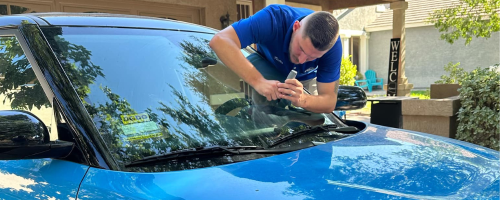Introduction:
Auto-glass recycling stands at the forefront of sustainable practices in the automotive industry. As we strive to build a greener future, addressing the challenges impeding the progress of auto-glass recycling is crucial. This comprehensive article explores ten key challenges and their corresponding solutions, shedding light on the intricate landscape of sustainable glass management. By understanding and overcoming these obstacles, we can pave the way for a more efficient and effective auto-glass recycling system. From the lack of awareness about the benefits of recycling to the difficulty in separating glass from other materials, this article delves into the industry’s complexities. It offers practical solutions to promote a circular economy for auto glass.
Challenges and Solutions in Auto Glass Recycling
Limited Collection Infrastructure
Challenge: The scarcity of dedicated collection centres for auto glass. This challenge hinders the efficient collection and transportation of auto glass for recycling. Without dedicated collection centres, it becomes more difficult for individuals and businesses to dispose of their auto glass properly, leading to a higher likelihood of it ending up in landfills.
Solution: Establish a widespread network of collection points, partner with auto repair shops, and incentivize consumers for glass return. To address this issue, establishing more dedicated collection centres specifically for auto glass recycling would provide a convenient and accessible solution for proper disposal and encourage greater participation in recycling. It also implements awareness campaigns to educate the public about recycling auto glass.
Contamination Concerns
Challenge: Contamination of auto glass with other materials, affecting recyclability. One challenge in recycling auto glass is the potential for contamination. Auto glass may contain contaminants such as adhesives, tinting films, or coatings, making the recycling process more difficult.
Solution: Implement rigorous sorting processes at collection points and educate consumers on proper disposal practices. To overcome this challenge, implementing stricter guidelines and quality control measures during the collection and sorting process would help ensure that only clean and uncontaminated auto glass is recycled. Investing in research and development to find innovative methods for separating contaminants from auto glass could further improve the recycling process.
Lack of Consumer Awareness
Challenge: Many consumers are unaware of the importance of recycling auto glass. This lack of awareness often leads to auto glass being disposed of in regular waste streams instead of properly recycled. To address this challenge, it is crucial to launch comprehensive awareness campaigns highlighting the environmental benefits of recycling auto glass and educating consumers on how and where to recycle it.
Solution: Launching awareness campaigns, collaborating with auto manufacturers to include recycling information in user manuals, and leveraging social media to reach a wider audience. In addition, partnering with local recycling centres and waste management facilities to ensure convenient and accessible drop-off locations for glass recycling can further facilitate the recycling process for consumers. Moreover, implementing a reward system or offering discounts on new auto products for those actively participating in recycling initiatives could serve as an additional incentive for consumers to engage in sustainable practices.
Technological Barriers to Recycling
Challenge: Outdated or inefficient recycling technologies. Outdated or inefficient recycling technologies pose a significant challenge in the recycling industry. These technologies may not be able to process certain materials effectively or require excessive energy consumption, hindering the overall efficiency of the recycling process.
Solution: Investing in research and development to enhance recycling technologies, fostering collaboration between technology companies and recyclers. To overcome this challenge, investing in research and development of advanced recycling technologies can help improve the efficiency and effectiveness of recycling operations. Additionally, collaborating with technology companies and innovators to develop new and innovative recycling solutions can help address these technological barriers and pave the way for a more sustainable future.
Economic Viability in Auto Glass Recycling
Challenge: The cost of recycling exceeds the economic benefits. To address the financial viability challenge, exploring and implementing strategies that can make recycling more financially sustainable is crucial. This could involve incentivizing businesses and individuals to recycle through tax breaks or financial rewards.
Solution: Offering economic incentives, such as tax breaks or subsidies, to recycling facilities and exploring innovative revenue streams, like turning recycled glass into valuable products. Furthermore, analyzing alternative funding models such as public-private partnerships can help alleviate the financial burden on recycling operations and ensure their long-term viability.
Transportation Challenges
Challenge: High transportation costs for transporting auto glass to recycling centres. One of the major challenges in recycling is the cost and logistics of transporting recyclable materials from collection points to recycling facilities. This can be addressed by investing in efficient transportation infrastructure and implementing regional recycling hubs that reduce the distance travelled for recycling materials. Additionally, promoting collaboration between recycling facilities and transportation companies can lead to more cost-effective and streamlined recyclable transportation solutions.
Solution: Establish regional recycling centres to minimize transportation distances and collaborate with logistics companies to optimize transportation routes. Furthermore, utilizing advanced technology such as GPS tracking and route optimization software can further enhance the efficiency of recycling transportation. This would allow for real-time monitoring and adjustment of routes, ensuring that recyclables are transported in the most timely and cost-effective manner possible.
Regulatory Hurdles in Auto Glass Recycling
Challenge: Navigating through different regulations and policies regarding the transportation of recyclables across other regions and countries. Additionally, ensuring compliance with environmental standards and regulations can challenge implementing streamlined recyclable transportation solutions. Complex or unclear regulations hinder the growth of auto glass recycling.
Solution: Advocate for clearer regulations and collaborate with government agencies to streamline processes. It engages in industry-wide dialogues to address regulatory challenges. These efforts can help create a more efficient and sustainable recyclable transportation system. It reduces barriers and promotes the growth of glass recycling by working together with government agencies and industry stakeholders. It is possible to establish a framework that supports environmental compliance. While also facilitating the smooth movement of recyclable materials across regions and countries.
Insufficient Research on End Markets
Challenge: Insufficient research on end markets poses a significant challenge to the growth of auto-glass recycling. Without a clear understanding of the demand and potential uses for recycled auto glass, it becomes difficult for industry stakeholders to develop effective strategies and investments. Additionally, the lack of information on end markets can deter potential investors and hinder the development of a robust recycling infrastructure.
Solution: Investing in market research to identify and develop new applications for recycled glass, creating demand and ensuring a sustainable market. By conducting thorough market research, industry stakeholders can gain insights into the specific needs and preferences of potential customers, allowing them to tailor their products and services accordingly.
Resistance to Change in Auto Glass Recycling
Challenge: Resistance from traditional stakeholders in the automotive and glass industries. These stakeholders may resist change due to concerns about the cost and feasibility of implementing new recycling processes; however, by showcasing the potential economic and environmental benefits of investing in recycled auto glass.
Solution: Collaborate with industry leaders, showcase successful case studies, and emphasize the long-term benefits of embracing sustainable practices. By collaborating with industry leaders, the company can address the concerns of traditional stakeholders and demonstrate the viability of implementing new recycling processes.
Inadequate Funding for Research and Development
Challenge: Limited funding for research and development in auto-glass recycling. Securing adequate funding for research and development poses a significant challenge in implementing new recycling processes. Without sufficient financial resources, it becomes difficult to conduct necessary studies and experiments to optimize the efficiency and effectiveness of these processes.
Solution: Encouraging public and private investment in research initiatives, establishing grants for innovative projects, and fostering partnerships between academia and industry. These measures can help address the limited funding issue by attracting financial support from various sources.
Statistics about Auto Glass Recycling
- According to the Glass Packaging Institute, recycling one ton of glass saves approximately 1.2 tons of raw materials, reducing energy consumption and greenhouse gas emissions.
- The recycling rate for auto glass remains relatively low, with only about 25% of end-of-life auto glass being recycled globally (source: International Journal of Engineering Research & Technology).
- The Automotive Recyclers Association reports that recycling automotive glass saves over a ton of natural resources for every glass recycled, including 1,300 pounds of sand, 410 pounds of soda ash, and 380 pounds of limestone.
- A study by the EPA indicates that the energy saved by recycling one glass bottle can power a light bulb for four hours or a computer for 30 minutes.
- The World Economic Forum projects that circular economy practices, including glass recycling, could generate $4.5 trillion in economic benefits by 2030, demonstrating the potential for economic growth through sustainable practices.
Conclusion:
In conclusion, addressing the challenges in auto-glass recycling requires a multifaceted approach involving collaboration, innovation, and advocacy. By implementing the proposed solutions, we can pave the way for a more sustainable and environmentally friendly future in the auto glass recycling industry. Additionally, it raises awareness about the importance of automotive glass recycling among consumers. It also encourages them to choose environmentally friendly options, which can contribute to these initiatives’ success. Furthermore, regular evaluation and monitoring of the implemented measures will be crucial to ensure their effectiveness. It also makes any necessary adjustments for continuous improvement.
FAQs Auto Glass Recycling
Q: Why is auto glass recycling important?
A: Auto-glass recycling is crucial for environmental sustainability. It helps reduce waste, conserve resources, and minimizes the environmental impact of automotive glass disposal. Promoting and supporting auto glass recycling can contribute to a more sustainable and circular economy.
Q: How can I contribute to auto glass recycling as a consumer?
A: You can contribute by responsibly disposing of your damaged auto glass at designated collection points and supporting awareness campaigns. It chooses products from manufacturers committed to sustainable practices. By opting for these options, you can further reduce the demand for new automotive glass production. It contributes to the overall sustainability of the auto glass industry.
Q: What happens to recycled auto glass?
A: Recycled auto glass can be transformed into various products, including new glass containers and fibreglass insulation. Also, even road construction materials contribute to a circular economy. The glass is then melted down and used as raw material for manufacturing new products. It reduces the need for virgin materials and conserves energy in the production process.
Q: Are there any economic benefits to auto glass recycling?
A: Automotive glass recycling can have economic benefits, including job creation and cost savings for manufacturers using recycled materials. Its potential revenue streams from recycled glass products. Moreover, by promoting a sustainable and environmentally friendly image, companies that participate in auto glass recycling. It may attract more customers and gain a competitive edge in the market.
Q: How can we address contamination issues in auto glass recycling?
A: Implement effective sorting processes at collection points and educate consumers on proper disposal practices. It also leverages technology for advanced sorting techniques that can help address contamination concerns. Additionally, establish partnerships with local recycling facilities and invest in research. – Developing innovative cleaning methods can also contribute to reducing contamination in glass recycling.
Read More:




























